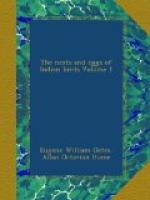But in this instance Captain Tickell may have been right, for I have once seen such a nest myself, and Mr. H.M. Adam writes:—“Near Sambhur, on the 7th July, I saw a pair of this species building a large cup-shaped nest in a babool tree;” while Colonel G.F.L. Marshall affirms that this species “frequently lays in cup-shaped nests of sticks placed in trees, like small Crows’ nests.” And he subsequently writes:—“I can distinctly reaffirm, what I said as to this species building a nest in the fork of a tree. In the compound of Kalunder gari choki, in the Bolundshahr district, I found no less than five of these nests on one day; the compound is densely planted with sheeshum trees, which were there about twenty feet high, and the nests were near the tops of these trees. I found several other similar nests on the canal-bank, one with young on the 11th September.”
Also writing in this connection from Allahabad, Major C.T. Bingham says:—
“Twice I have found the nest of this bird in trees, but it generally builds in holes, both in trees and walls, and commonly in the thatch of houses. Once I got a couple of eggs from a nest made amidst a thick-growing creeper.”
Neglecting exceptional cases like these, the nest is a shapeless but warm lining to the hole, composed chiefly of straw and feathers, but in which fine twigs, bits of cotton, strips of rags, bits of old rope, and all kinds of odds and ends may at times be found incorporated.
The normal breeding-season lasts from June to August, during which period they rear two broods; but in Ross Island (Andamans), where they were introduced some years ago, they seem to breed all-through the year. Captain Wimberley, who sent me some of their eggs thence, remarks:—“The bird is now very common here. As soon as it has cleared out one young brood, it commences building and laying again. This continues all the year round.”
I think this great prolificness may be connected with the uniformly warm temperature of these islands and the great heat of the sun there all through the year rendering much incubation unnecessary. Even in the plains of Northern India in the hot weather when they breed these birds do not sit close, and since at the Andamans the weather is such all the year round that the eggs almost hatch themselves this may be partly the reason why these birds have so many more broods there than with us, where, for at least half the year, constant incubation would be necessary. I particularly noticed when at Bareilly how very little trouble these Mynas sometimes took in hatching their eggs, and I may quote what I then recorded about the matter:—




